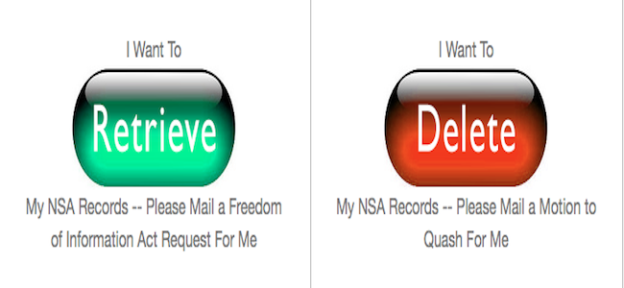 After the PRISM leak, you probably want to know exactly what the NSA has on file about you. And here’s some good news amid all the are-we-living-in-a-surveillance-state hand-wringing: Civil rights advocate Jonathan Corbett put together a website called My NSA Records that wants to help you understand what your records looks like.
After the PRISM leak, you probably want to know exactly what the NSA has on file about you. And here’s some good news amid all the are-we-living-in-a-surveillance-state hand-wringing: Civil rights advocate Jonathan Corbett put together a website called My NSA Records that wants to help you understand what your records looks like.
My NSA Records gives you two options: You can ask to retrieve your NSA records by filing a Freedom of Information Act (FOIA) request, which My NSA Records will print and mail for you, free of charge. Or you can ask that your NSA records are deleted by filing a Motion to Quash (the most hilariously-named motion) with the Foreign Intelligence Surveillance Court (FISC).
My NSA Records already sent out over 500 requests to the FOIA, but Corbett hit a roadblock when he tried to send requests to quash to the FISC. This is because there is no public address listed for the FISC, despite the fact that it’s a government court. Corbett discovered that he had to call a number to get the address for the court. But when he called a number, according to his blog post, “things got weirder.”
“I left a message, which was returned yesterday by a pleasant sounding woman who told me to reach a woman named Christine Gunning,” Corbett explains in his blog. “I asked if this woman was a representative of the clerk, and I was told, ‘No.’ Well then who is she? ‘She works for the Department of Justice.'”
“The idea that there is a court in the United States of America that has not even a mailing address is absolutely astounding. But upon further research, “the FISC” appears not to actually exist, at least as a physical court room. The idea that in order to reach the judicial branch, I must ask the executive branch to process my request is antithetical to the separation of powers required by our constitution. But, this whole deal – the spying, the secret courts, the lying to us to ‘protect us’ – it’s all antithetical to our values, isn’t it?”
While Corbett had trouble trying to locate the mailing address, he eventually found it. “I do have an address for filing with the FISC at this time, and the first FISC motions will be mailed today,” he told us. He published the address to the same blog post yesterday. If you just want to mail Ms. Gunning your FISC petition without going through the My NSA Records website, this is where you should send it (and make it out to Ms. Gunning):
2 Constitution Sq.
145 N St. NE, Ste. 2W-115
Washington, DC 20530
Getting the address is an important step, though Corbett wasn’t optimistic when asked if these requests might get stonewalled. “Definitely. I don’t think the NSA is giving up or deleting records without a fight, and I don’t think the FISC will be terribly sympathetic. The idea, however, is not for people to expect their request to be handed to them in a few weeks, but rather it’s more of a protest. Having the NSA and FISC feel that they are starting to be held accountable by the public is so important. They wouldn’t have been able to do the things that they did in the light of day, and these requests, whether accepted or rejected, send a powerful message: We are watching you.”
Corbett said that the FOIA generally has a processing time of one month, but it can take longer, and that “the agency has a significant amount of leeway.” So you probably shouldn’t hold your breath about getting a response from these requests in anything remotely resembling a timely manner. Though, as Corbett noted, even if you don’t get the NSA records you want, at least you’re showing the government that this surveillance program worries you.
Editors' Recommendations
- What’ll happen to your WhatsApp account if you don’t agree to new privacy policy
- Don’t be like Pierre Delecto. Here’s how to keep your Twitter account a secret
